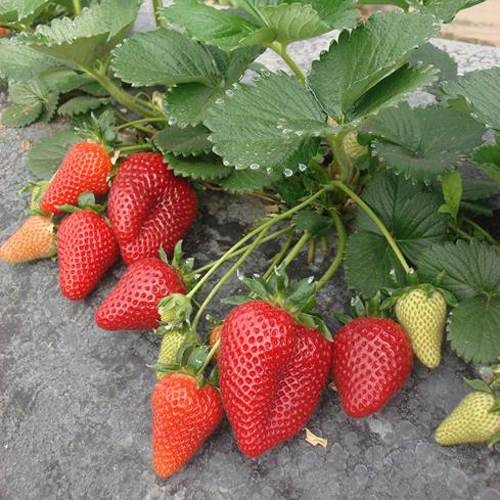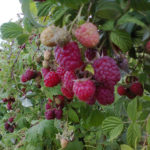Malga strawberry variety
Malga is a remontant variety of garden strawberries (strawberries) for universal use. It was bred in 2018 in Verona (Italy) by a private breeder Franco Zenti, who is known in the world of berry crop lovers for opening farms around the world, testing plants in different climatic conditions. The novelty he created proved to be very good in everything. The variety turned out to be both fruitful and tasty, and resistant to negative natural phenomena, such as heat, drought and prolonged rains. In addition, plants have excellent immunity, so this remontant is recognized as one of the best for organic farming. Strawberries thrive both in the open field and in film tunnels, and in containers, can also be used as a balcony culture. The originator of the variety is the Italian company New Fruits, at the moment the novelty is actively grown in European countries, it came to the Russian and Ukrainian markets not so long ago, but it is rapidly gaining popularity and good reviews.

The plant is medium-sized, moderately leafy, rather compact. The bushes are of a compressed type, which makes it possible to grow this variety in compacted plantings. Leaves of medium size, rich bright green color, slightly wrinkled. The formation is scarce. Strawberry flower stalks are tall, long, multi-primordial, formed in large quantities, sink to the ground under the weight of the fruit.
Malga berries are large and very large in size. Fruits are leveled, very beautiful, regular elongated-conical shape, which remains throughout the entire period of fruiting. The skin is shiny, bright red with an orange tint. Achenes are small, depressed to a medium depth. The pulp without voids, juicy, has a very dense consistency, but does not crunch, which is typical, for example, for Albion and some other high-yielding remontants.
Strawberry tastes great. The berries are sweet, juicy, with a delicate strawberry aroma, not devoid of light pleasant sourness. It should be noted that in rainy weather, the sugar content of the fruit may suffer, but this is typical for many other varieties. In general, gardeners are very pleased with the taste of this variety. The berries are versatile in use, have an excellent presentation, which makes Malga a good option for growing commercially. The fruits are excellently transported due to the dense pulp consistency, and also tolerate freezing very well. Jam or jam from this strawberry will also turn out excellent.

The average weight of berries per season is 25-30 grams. In the first waves of the harvest, the fruits are larger - up to 50 grams, however, throughout the entire period of fruiting, the berries remain large - at least 20 grams. However, the harvest may be shallower due to lack of sunlight, or due to very intense heat. In protected ground conditions, the fruit size is stable throughout the season.
The yield of the variety is high, with standard agricultural technology it is quite possible to get 1 kg of berries per plant, but this indicator is not the limit. The species appeared not so long ago, so it is too early to judge its real potential, moreover, it manifests itself in different ways in different climatic conditions. So, in the Moscow region, our heroine significantly surpasses a promising novelty Cabrillo in terms of yield and weight of berries, however, in the more southern regions, Malga is already beginning to yield.
The strawberries are early ripe, they begin to ripen in early-mid-May, although in some regions they can ripen in the early-mid-term - at the end of May. Also, the variety is distinguished by its early maturity, from the moment of flowering to the technical ripeness of the berries, it takes about two weeks. Fruiting in our heroine is extended, stable, the intervals between waves are short, the berries do not lose size.In the open field, strawberries bear fruit until frost; in protected ground, as befits a variety of neutral daylight hours, it can yield a harvest all year round. In terms of yield and uniformity of berry sizes throughout the season, the variety proudly keeps on par with the popular remontant novelties of the market Murano, Vivara and Cabrillo, although it is worth noting that the latter three are often credited with much greater yield potential than our heroine, however, these exorbitant figures are rarely achieved.
Plants thrive in a continental climate, in mountainous and lowland areas. The culture is very light-loving, but does not like the scorching sun - the berries are baked. With a lack of light, the sugar content of the fruits decreases, so you should take care of shading the plantings during the peak of the sun, while avoiding excessive shading. Also, our heroine does not feel very well in dampness, a more pronounced sourness appears in the berries. In general, compared to other remontants, this strawberry is more resistant to cold and rainy weather, but in any case, this will affect the quality and taste of the crop. The originator states that the optimum temperature for the full potential of the plants is between 20 ° C and 25 ° C. According to gardeners, the variety does not particularly like the heat - the yield decreases during the hottest summer months, then rises again with the arrival of a decrease in temperatures in August-September.
Malga has excellent immunity, does not require a lot of processing, and can also be used in organic farming. Nevertheless, it should be noted that the likelihood of the appearance of diseases still remains, especially in adverse weather conditions and high humidity, so you should not neglect the minimum preventive measures. There are no official data regarding frost resistance, and the opinions of gardeners differ, but it can be assumed that our heroine, like many other varieties of Italian selection, is not adapted to harsh winters. Therefore, it is better, just in case, to take care of a good shelter of strawberries if they are grown in a region with cold winters with little snow.
Summing up, it should be said that Malga is indeed a very good and promising novelty in the range of remontant varieties. At the moment, there are many disagreements about how our heroine behaves in different climatic conditions, which gives rise to disputes about the real yield of the variety. Well, try to grow these strawberries on your site and draw your own conclusions. The novelty has not yet had time to settle down well on the market, so the price of planting material is currently acceptable and allows you to experiment.








